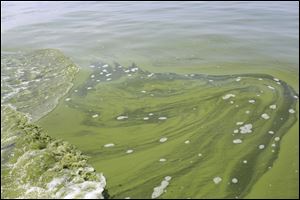
State lawmakers approve Lake Erie funding bill
6/27/2018COLUMBUS — As the annual peak season for toxic algal blooms on Lake Erie approaches, lawmakers on Wednesday finalized a bipartisan measure putting $36 million more in state funds behind efforts to tackle the issue even as critics argue that just throwing more money at the problem isn’t the answer.
Before recessing for the summer, the House voted unanimously to send the Senate a revised version of Senate Bill 299, sponsored by Sens. Randy Gardner (R., Bowling Green) and Sean O’Brien (D., Cortland). The Senate voted unanimously to forward it on to Gov. John Kasich for his signature.
RELATED CONTENT: Bill protecting e-school heads to governor ■ Last minute bills move in Ohio House, Senate

Ohio's Senate Bill 299 calls for $36 million more in state funds to fight algal blooms.
The two chambers then planned to recess for the summer after moving dozens of bills at the last minute.
“The open waters of Lake Erie have been called distressed,” said Rep. Steve Arndt (R., Port Clinton), sponsor of a similar House bill. “We have continued to see extreme algal blooms.
“It’s a very good piece of legislation that’s going to allow us to meet the compact that we agreed upon [with Michigan and Ontario] to reduce phosphorous loading by 40 percent by 2025,” he said. “The reports have indicated very clearly that, at this particular place where we are, that we will not meet our end of the obligation to make that reduction.”
While the additional funds help farmers in their voluntary efforts to reduce the amount of phosphorous runoff from their fields that feeds the green slime once it reaches the lake, the Kasich administration and environmental groups argue such voluntary efforts haven’t made much of a difference to date.
No lawmaker has been willing to introduce a bill pushed by the administration to put more teeth behind the state’s response as it nears the 2025 deadline.
And lawmakers expect that, absent such a bill, Mr. Kasich could act via executive order.
Senate Bill 299, dubbed the Clean Lake 2020 Plan, would earmark $2.65 million to the Ohio State Sea Grant and Stone Lab to research and monitor phosphorous loading, harmful algal growth, and toxicity levels; $10 million to research alternative uses for dredged sediment; up to $20 million in grants and loans to farmers in their efforts to reduce phosphorous runoff; and $3.5 million for soil and water conservation districts in the lake’s western basin.
Rep. Mike Sheehy (D., Oregon) joined the Ohio Environmental Council and the National Wildlife Federation at a news conference on Tuesday, the day before the final votes to seek more aggressive action. Mr. Sheehy’s bill to cap the application of manure and other fertilizers to farmland above what is needed has seen no action.
“Everybody agrees that more needs to be done,” he said Wednesday. “This legislation is more, and it’s addressing the algae in the Maumee region and to some extent we’re looking at the nutrient loads coming down the Ohio River.”
The Kasich administration wants to impose statewide a maximum phosphorous discharge limit already applied to many wastewater treatment plants on the lake and to change the definition of “agricultural pollution” to include fertilizers so the Department of Agriculture can force action by farmers when a watershed is declared to be in distress.
“Science has overwhelmingly demonstrated that out-of-control agricultural runoff, the source of 88 percent of added phosphorous each year, is the largest source of this problem,” he said.
Contact Jim Provance at: jprovance@theblade.com or 614-221-0496.